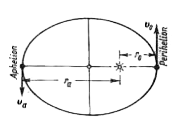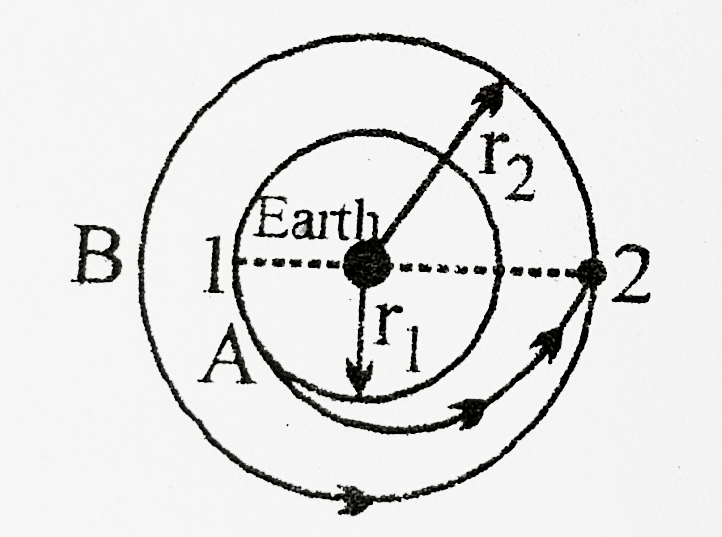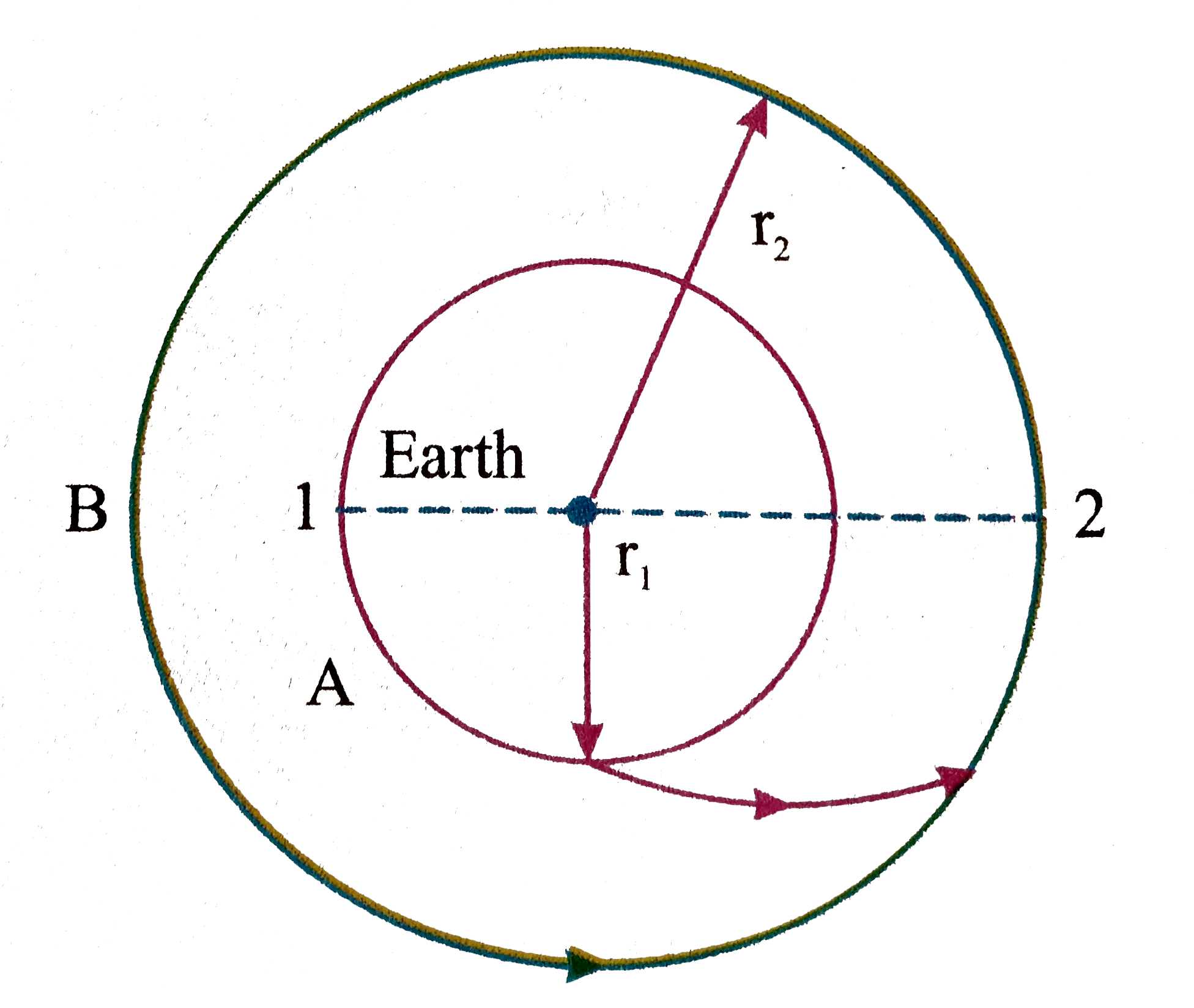A satellite is in a circular orbit very close to the surface of a planet. At some point it is given an impulse along its direction of motion, causing its velocity to increase n times . It now goes into an elliptical orbit. The maximum possible value of n for this to occur is
2
√2
√2+1
1√2−1
The correct Answer is:B
The initial velocity of the satellite is v=√GMR
The satellite will remain in the elliptical orbit as long as v<ve where ve is the escape velocity.
Also ve=√2GMR
∴nv≤ve or n√GMR≤√2GMR
n≤√2 or nmax=√2
Topper's Solved these Questions
- BOOK - MTG GUIDECHAPTER - GRAVITATIONEXERCISE - CHECK YOUR NEET VITALS25videos
GRAVITATION
- BOOK - MTG GUIDECHAPTER - GRAVITATIONEXERCISE - AIPMT/NEET MCQS32videos
GRAVITATION
- BOOK - MTG GUIDECHAPTER - GRAVITATIONEXERCISE - NEET CAFE TOPICWISE PRACTICE QUESTIONS (GRAVITATIONAL POTENTIAL ENERGY AND GRAVITATIONAL POTENTIAL)6videos
GRAVITATION
- BOOK - MTG GUIDECHAPTER - BEHAVIOUR OF PERFECT GAS AND KINETIC THEORYEXERCISE - AIPMT / NEET (MCQs)11videos
BEHAVIOUR OF PERFECT GAS AND KINETIC THEORY
- BOOK - MTG GUIDECHAPTER - KINEMATICS EXERCISE - AIPMT/ NEET MCQs31videos
KINEMATICS
Similar Questions
A satellite revolves close to the surface of a planet. How is its orbital velocity related with escape velocity of that planet.
View SolutionThe point of an elliptical orbit closest to the Sun is called the perihelion, and the point most distant from it is called aphelion (Fig). Denoting the distance from the perihelion to the Sun by r0 and the velocity of the planet at the perihelion by v0 , find the radius of curvature of the orbit at the perihelion and at the aphelion, the distance from the aphelion to the Sun, and the velocity of the planet at the aphelion.
Prove that the motion of a planet in an elliptical orbit is only possible, if its total energy is negative.
 View Solution
View Solution
Knowledge Check
- Question 1 - Select One
A satellite is orbiting very close to a planet. Its periodic time depends only on
Adensity of the planetBmass of the planetCradius of the planetDmass of the satellite - Question 2 - Select One
If a satellite is orbiting the earth very close to its surface, then the orbital velocity mainly depends on
AThe mass of the satellite onlyBThe radius of the earth onlyCThe orbital radius onlyDThe mass of the earth only - Question 3 - Select One
A satellite is revolving around earth in a circular orbit. At some instant the speed of the satellite is increased √2 times its orbital speed keeping its direction unchanged. Then, the new path of the satellite is :
AcircularBstraight lineCellipticalDparabolic
A small satellite revolves around a heavy planet in a circular orbit. At a point in its orbit an impulse acts suddenly and instantaneously increases its kinetic energy K times without change in its direction of motion. The ratio of maximum to the minimum distance from the planet is [Assume mass of satellite is negligible small compared to that of planet]
View Solutionsatellite revolving in circular orbit suppose V0 is the orbital speed, T its time period, u its potential energy and K the kinetic energy. Now value of G is decreasesd. Then
View SolutionTwo satellites A and B are revolving around the earth circular orbits of radius r1 and r2 respectively with r1<r2. Plane of motion of the two are same. At position 1, A is given an impulse in the direction of velocity by firing a rocket so that it follows an elliptical path to meet B at position 2 as shown. A?t position 2, A is given another impluse so that velocities of A and B at 2 become equal and the move together.

For any elliptical path of the satellite of the time period of revolution is given by Kepler's planetary law as T2αr3 where a is semi major axis of the ellipse which is r1+r22 in this case. Also angular mopmentum of any satellite revolving around the Earth will remain a constant about EArth's centre as force of gravity on the satellite which keeps it in elliptical path is along its position vector relative to the earth centre.
If the two have same massView Solution
Two satellites A and B are revolving around the earth in circular orbits of radius r1 and r2 respectively with r1<r2. Plane of motion of the two are same. At position 1, A is given an impulse in the direction of velocity by firing a rocket so that it follows an elliptical path to meet B at position 2 as shown. focal lengths of the elliptical path are r1 and r2 respectively. at position 2, A is given another impulse so that velocities of A and B at 2 become equal and the two move together. for any elliptical path of the satellite time period of revolution is given Kepler's planetry law as T2αr3 where a is semi-major axis of the ellipse which is r1+r22 in this case. also angular momentum of any satellite revolving around the earth will remain a constant about earth's centre as force of gravity on the satellite which keeps it in elliptical path is given its position vector relative to the earth centre.
When A is given its first impulse at that momentView SolutionTwo satellites A and B are revolving around the earth circular orbits of radius r1 and r2 respectively with r1<r2. Plane of motion of the two are same. At position 1, A is given an impulse in the direction of velocity by firing a rocket so that it follows an elliptical path to meet B at position 2 as shown. A?t position 2, A is given another impluse so that velocities of A and B at 2 become equal and the move together.

For any elliptical path of the satellite of the time period of revolution is given by Kepler's planetary law as T2αr3 where a is semi major axis of the ellipse which is r1+r22 in this case. Also angular mopmentum of any satellite revolving around the Earth will remain a constant about EArth's centre as force of gravity on the satellite which keeps it in elliptical path is along its position vector relative to the earth centre.
When A is given its first impulse at the moment.View Solution

